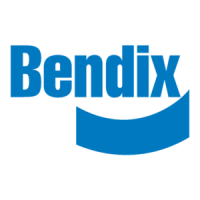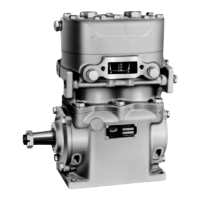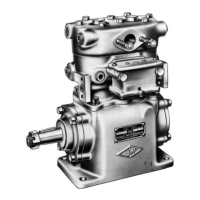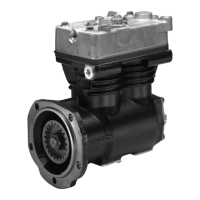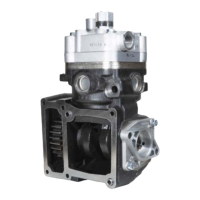6
If a previously unturbocharged compressor is being turbo-
charged, it is recommended that the inlet cavity screen
(238948) be installed with an inlet gasket (291909) on both
sides of the screen.
COMPRESSOR TURBOCHARGING
PARAMETERS
Air entering the compressor inlet during the loaded cycle
must not exceed 250 degrees Fahrenheit (121 degrees Cel-
sius). A metal inlet line is suggested to help meet this
parameter.
The following compressor crankshaft rotative speed and in-
let pressure relationships may not be exceeded.
Crankshaft Maximum CompressorR.P.M.
Inlet Pressure
1900 RPM 30.0 psi (207 kPa)
2000 RPM 27.5 psi (190 kPa)
2100 RPM 24.0 psi (165 kPa)
2200 RPM 21.0 psi (145 kPa)
2300 RPM 19.0 psi (131 kPa)
2400 RPM 16.0 psi (110 kPa)
AIR INDUCTION
One of the single most important aspects of compressor
preventive maintenance is the induction of clean air. The
type and interval of maintenance required will vary depending
upon the air induction system used.
The intervals listed under the headings below pertain to typi-
cal highway and street operation. More frequent maintenance
will be required for operation in dusty or dirty environments.
0
20
25
15
35
5
30
270024002100180015001200900600
10
Compressor Speed (RPM)
Inlet Pressure (PSIG)
Turbo Limits
FIGURE 9 - TURBO LIMITS CURVE
PREVENTATIVE MAINTENANCE
Regularly scheduled maintenance is the single most impor-
tant factor in maintaining the air brake charging system.
Refer to Table A in the Troubleshooting section for a guide to
various considerations that must be given to the mainte-
nance of the compressor and other related charging system
components.
Important Note: Review the warranty policy before perform-
ing any intrusive maintenance procedures. An extended
warranty may be voided if intrusive maintenance is performed
during this period.
PAPER AIR STRAINER DRY ELEMENT-PLEATED
POLYURETHANE SPONGE STRAINER
FIGURE 10 - STRAINERS
POLYURETHANE SPONGE STRAINER
Every month, 150 operating hours or 5,000 miles, which-
ever occurs first, remove and wash all of the parts. The
strainer element should be cleaned or replaced. If the ele-
ment is cleaned, it should be washed in a commercial solvent
or a detergent and water solution. The element should be
saturated in clean engine oil, then squeezed dry before re-
placing it in the strainer. Be sure to replace the air strainer
gasket if the entire strainer is removed from the compressor
intake.
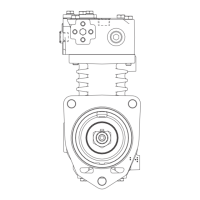
